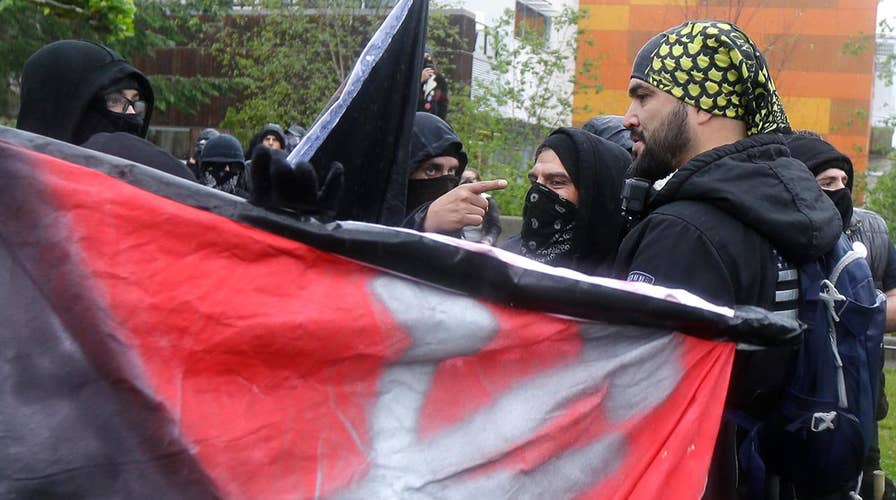Antifa: What is the alt-left group?
Alt-left anti-fascist activist group, 'Antifa,' continues to show up at political protests on college campuses across the US, sparking violence to promote its agenda
Well before the deadly Aug. 12 rally in Charlottesville and the ongoing violent clashes with white supremacists and other groups, federal authorities warned local officials the actions of left-wing extremists were becoming increasingly confrontational and dangerous.
Federal agencies warned of the growing likelihood of lethal violence between left-wing anarchists and right-wing white supremacists.
Some even classified their activities as “domestic terrorist violence.”
In previously unreported documents dating back to April 2016 and viewed by Fox News, the FBI and Department of Homeland Security wrote that “anarchist extremists” and Antifa groups were the primary instigators of violence at public rallies. They blamed these groups for attacks on police, government and political institutions, racists, fascists and “symbols of capitalism.”
The agencies warned the rise of fascist, nationalist, racist or anti-immigrant groups in U.S. political discourse could lead to violent backlash from these “anarchist extremists.”
The FBI and DHS had no comment on the assessments, saying they were not intended to be made public.
POLITICO was the first to report on the documents Friday.
Brian Levin, a former New York City police officer who monitors domestic militants at the Center for Study of Hate and Extremism at California State University, San Bernardino, cautioned calling all members of the Antifa movement “domestic terrorists,” and said not all tolerate the use of violence while protesting.
“People in this movement allow for confronting, jostling, committing low-level types of offenses, but there has been for some time a core that have tipped the movement to confrontational violence,” he told Fox News on Friday. “The hardest edge in the Antifa spectrum comes under that category...not all Antifa are busting heads”
He added the same could be said for members of the alt-right, some of whom tolerate and justify the use of violence.
In recent decades, authorities have focused almost exclusively on right-wing groups as the most likely instigators of domestic terrorist violence, especially after Timothy McVeigh blew up the Oklahoma City federal building in 1995, killing 168 people.
But groups such as Antifa, which is short for anti-fascist, have been growing in numbers and becoming more tolerant about using violence.
The violent clashes in Charlottesville on Aug. 12 that left one woman dead was only one recent event that drew dozens -- and in some cases hundreds -- of people on both sides, many of whom were armed and looking for a fight.
Some DHS and FBI intelligence reports began flagging protesters before the election, POLITICO reported.
“The socio-political landscape has changed,” Levin said. “The same way white nationalists used Obama as a figure to rally about...now Antifa and anarchists see in Trump a broad-base [enemy] that has united them.”
He added: “There is a sense that we are getting divided.”
Some law enforcement officials told POLITICO Trump’s election in November also gave Antifa activists a new target, separate from white nationalist groups: Trump supporters.
“It was in that period [as the Trump campaign emerged] that we really became aware of them,” a senior law enforcement official tracking domestic extremists told POLITICO. “These Antifa guys were showing up with weapons, shields and bike helmets and just beating the s--- out of people...They’re using Molotov cocktails, they’re starting fires, they’re throwing bombs and smashing windows.”
Specifically, the target became those from white supremacist and nationalist groups who came out in droves hailing Trump’s win and calling for further crackdowns on illegal immigrants and other groups. Those forces -- along with more traditional and less controversial demonstrators -- have also turned out to protest the removal of Confederate statues, which is what spurred the rally in Virginia.
Law enforcement officials said Trump’s rhetoric and policies further fueled motivations on both sides.
“Every time they have one of these protests where both sides are bringing guns, there are sphincters tightening in my world. Emotions get high, and fingers get twitchy on the trigger,” one official told POLITICO.
Levin called it “an escalating arms race” that spill onto social media and then back onto the streets with more people.
POLITICO reported recent FBI and DHS reports confirm they are actively monitoring “conduct deemed potentially suspicious and indicative of terrorist activity” by Antifa groups.
But one report acknowledged several significant “intelligence gaps,” including an inability to penetrate the groups’ “diffuse and decentralized organizational structure.” They said this makes it harder for law enforcement to identify violent groups and individuals.
“There’s a lot more we don’t know about these groups than what we do know about them,” one New Jersey law enforcement official told POLITICO.
Levin said it’s hard to forecast what will happen in the future, calling it a “fluid situation,” but to expect clashes to continue -- and grow larger and more frequent.
“[Antifa’s] list of what is fascist has grown far beyond the loathsome, Swastika-carrying white nationalists, to controversial conservatives, speakers, the police, journalists and random people who get in their way,” he said.






















